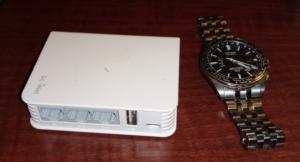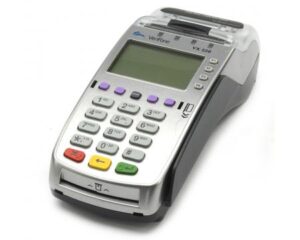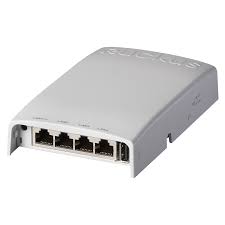
My favorite travel router these days is the GL-AR750 (pictured at right). I used to go through travel routers at the rate of several per year, but this one has kept me happy for more than a year now. In this blog post I will list the functions that you might look for in a travel router and I will describe how this router does at those functions.
Raison d’être. The first thing to discuss, I guess, is “what is the problem for which a travel router is the solution?” And there are several such problems as I will describe.
The loaves and the fishes. Years ago the problem that needed fixing was that a hotel would gouge customers by charging a lot of money per day for the ability to connect exactly one device to the Internet. The immediate reaction of the guest was to set it up so that the “exactly one device” was a travel router, which would in turn permit the guest’s several devices to share one expensive connection to the Internet. The alert reader is instantly reminded of the two “feeding the multitude” miracles attributed to Jesus.
A variant of this is the traveling party booking two or more guest rooms in the hotel, and arranging for the rooms to be adjacent. One guest connects up a travel router after having paid once for the expensive connection, and then provides connectivity to the other guest rooms via wifi.
Nowadays these reasons for carrying a travel router does not present itself quite so often, since many hotels nowadays provide the Internet access for free, and even if you have to pay, the hotel will typically connect multiple devices for that fee.
But yes the GL-AR750 can provide these functions.
Providing an ethernet connection in a wifi environment. What does arise quite often in today’s world is that one is in a place such as a hotel or meeting room where the only way to connect to the Internet is by wifi. And one has a device that needs to get an Internet connection by means of a physical ethernet cable.
Cordless VOIP phone when traveling. For example I usually travel with a DP750 base station for VOIP cordless phones. This permits me to bring a cordless extension of my office phone system with me to my hotel in a very convenient way. But the base station requires an ethernet connection which the hotel may not have. The LAN port on the travel router saves the day. The GL-AR750 can provide this function. Not only that, the DP750 base station is USB-powered and can get its power from the USB port on the GL-AR750 router.

Credit card swipe terminal. Every now and then I need to bring one of the firm’s VX520 credit card swipe terminals along on a trip. Yes, I know there are lots of ways to process credit cards using little gadgets that you plug into your smart phone. But those gadgets are fiddly and a helper might not be able to figure out right away how to use it. And they don’t print receipts and the customer who wants to “tap to pay” won’t be able to do so. And if the customer wants to pay with a debit card (meaning they may need to be able to key in a PIN number), the fiddly gadget will not have an industry-approved non-eavesdroppable PIN pad. The super reliable way to go is a swipe terminal like this which is easy to learn to use, supports chip cards, supports tap to pay, prints receipts, and has a non-eavesdroppable PIN pad. Which is all fine and good except this kind of terminal needs an ethernet conection. And once again the LAN port on the travel router saves the day.
WISP. What comes up quite often in my travels is that the hotel provides wifi Internet and not wired (ethernet) Internet. And I have multiple devices including a notebook computer, a smart phone, and a Fire TV stick that all need to connect. Yes I could laboriously connect each of them to the hotel’s wifi through the “terms and conditions” portal. But instead it is super easy simply to connect the router to the hotel wifi and then connect my many devices to the router’s wifi. This function is sometimes called a “repeater” function or WISP (wireless internet service provider) function. The GL-AR750 can provide this function.
Wifi bands. These days you might want to connect to a hotel’s 2.4 GHz wifi network. Or you might want to connect to a hotel’s 5GHz wifi network. Meanwhile you might want the travel router to provide both kinds of wifi for your various devices. The GL-AR750 supports both wifi bands.
MIMO. In the old days the data rate that could pass over a wifi link was some data rate defined by the modulation being used. A typical maximum theoretical data rate in the 2.4 GHz band was 11 megabits per second. Nowadays it is commonplace in a wifi router or access point to use multiple antennas, each oriented in a different way, each of which has its own radio, each radio having its own data path to the other ports of the router or access point. If the wifi client also happens to have this hardware-rich set of multiple antennas, each with its own radio, each radio having its own data path, then the two devices may be so lucky as to be able to negotiate two or more RF links (making use of multipath propagation). The happy result might be a data rate of up to 300 megabits per second in the 2.4 GHz band and a data rate of up to 433 megabits per second in the 5 GHz band. The GL-AR750 provides MIMO with these theoretical speeds. (In real life the hotel is never going to be providing a connection faster than about 30 megabits per second.)
Size. The GL-AR750 router is a mere 88 by 68 by 24 millimeters (3½ by 2¾ by 1 inch) in size. The photograph shows this router next to a wristwatch, to give a sense of scale. The router does not take up a lot of space in one’s suitcase when traveling.
Weight. This router weighs 66 grams (about 2½ ounces). It is not very heavy to bring along when traveling.
Power source. Some of the previous travel routers that I used got their power from a “wall wart” meaning an AC adapter. This was annoying on several levels.
First, it meant that the putative size and weight of the travel router was deceptive. The true size and weight could only be appreciated by adding up the size and weight of the router together with its wall wart.
Second, the wall wart is one more thing to misplace. It is one more thing that might break or stop working.
The GL-AR750 gets its power from a USB port, the same kind of USB port that you might use for charging up a phone or tablet. This means that any old phone charger and charging cable can be used to power this router. If the charger breaks you use a different one. Some hotels provide USB charging ports, in which case such a charging port may be employed as the power supply for the router.
This also means that if I have a USB power brick with me, I can use it to power the router.

POE. One version of the GL-AR750 has the ability to get powered by a Power Over Ethernet connection at its WAN port. (Yes you should buy that version if you decide to get one of these routers.) Sometimes I will be so lucky that the hotel where I am staying uses Ruckus boxes for the Internet connectivity, and one of the ethernet ports on the Ruckus box will supply power over ethernet. In those hotels I can connect my router by its WAN port to the Ruckus box and this provides ethernet data and also power for the router. When this works out, it is very convenient.
Power consumption. This router consumes less than six watts. There just aren’t any routers that consume less power than this one.
VPNs. These days one of the most important features for travel is the use of VPNs. VPNs are important as a way of securing one’s activities from prying eyes, and are important as a way of securely connecting to the network at one’s office. In addition, many travelers whose travels take them outside of the US find that they cannot view the latest episode of their favorite program on a streaming service such as HBO Now or Hulu or Netflix or Amazon or CBS All Access.
The GL-AR750 router has built-in VPN clients for OpenVPN and WireGuard VPN services. This makes it very easy to plug in the router, connect to the hotel’s wifi, turn on the VPN with a connection to a point in the US, and stream the latest episode despite being located outside of the US. (Of course as an intellectual property lawyer I cannot condone any use of a streaming service that goes against the terms and conditions of that streaming service!) Such a VPN connection could for example work with a Fire TV stick that is plugged into the hotel’s television.
For some travelers the VPN connection is important simply to prevent anyone, including the hotel, knowing which Internet sites the traveler is visiting. If a hotel blocks certain Internet sites, the VPN bypasses such a block and permits access to the site.
File sharing. A feature that most travel routers support, and that I only rarely make use of, is Samba file sharing. You can plug a micro SD card into a slot on the router and you can share this card as a drive letter to computers and other devices connected to the router’s LAN ports, namely the 2.4 GHz LAN port, the 5 GHz LAN port and the ethernet LAN port. You can do the same with a USB hard drive or thumb drive that is plugged into the USB port of the router. I imagine this could be a powerful collaborative work facilitation capability if you were to have two or three people working together on a project while traveling in a hotel room or conference room. The GL-AR750 supports these file sharing functions.
Ethernet WAN port. For this router, the WAN port tops out at 100 Mbps. This might seem slow in a world where so much ethernet nowadays is gigabit ethernet. But consider that the speed provided by the hotel’s Internet connection will never be faster than about 30 megabits per second. So 100 Mbps is fast enough.
Ethernet LAN ports. This router provides not one but two ethernet LAN ports, which sets it apart from many other travel routers that have either one ethernet LAN port or no ethernet LAN ports. The ports have a speed of 100 Mbps which again is faster than whatever speed the hotel will provide.
USB port. Above I mentioned that the router has a USB port, and that I often make use of that port to supply power to a VOIP cordless phone base station. The USB port can also be used to charge up your phone. But very interestingly the firmware in the router permits the USB port to be used in another very interesting way, namely as a place to plug in a USB cellular modem. Yes, depending on where you are traveling you might choose to get a local SIM card with a data plan, along with a 3G or 4G cellular modem. This modem can be plugged in to the USB port and the router can be configured to get its Internet connection from that device rather than from wifi or from the ethernet WAN port.
The tech-savvy reader will appreciate that any router these days has a NAT (network address translation) engine inside, which expands one WAN IP address into as many as 253 LAN IP addresses. (This is part of what makes possible the multiplication of the loaves and fishes metaphorical activity.) The defining characteristic of a modern-day travel router is that you have this NAT router and you get to pick where exactly the NAT engine gets its Internet connectivity. In a feature-rich router such as the GL-AR750, the choices for the source of Internet connectivity include:
- the ethernet WAN port,
- a 2.4 GHz wifi client,
- a 5 GHz wifi client, or
- a cellular modem plugged in to the USB port.
In a feature-rich router such as the GL-AR750, the choices for the clients making use of the Internet connectivity include:
- devices connected to either of the two ethernet LAN ports,
- devices connected to the 2.4 GHz wifi access point of the router, and
- devices connected to the 5 GHz wifi access point of the router.
It will also be appreciated you are not limited to two ethernet-connected devices. I once connected a sixteen-port ethernet switch to one of the LAN ports of this router, which made it possible to connect a dozen desktop computers to the router.
The user interface. People who, like me, have used various travel routers over the years will recall that some of the earliest routers had user interfaces that were nearly impossible to make sense of. The seemingly simple step of picking which of several ports should be used by the NAT engine as the way to connect to the Internet was, in those early days, an extremely complicated thing to configure. Fortunately by now the makers of travel routers have managed to come up with fairly good graphical user interfaces. The GL-AR750 has a particularly well designed and user-friendly GUI overlaid upon the OpenWRT router code base.
Astonishingly fast and effective tech support. One of the sites which I sometimes need to connect to using a VPN is a site that uses a particular type of VPN called PPTP (point-to-point tunneling protocol). PPTP uses TCP port 1723 and a protocol called Generic Route Encapsulation (GRE). With this GL-AR750 router (and with most previous travel routers) I had no difficulty turning on a PPTP connection on my notebook computer which would pass through the router and would permit me to reach the desired site.
Except that recently the manufacturer pushed out an update to the firmware, to a version number 3.010. This new version of firmware offered a much nicer graphical user interface, but unfortunately this firmware version failed to pass through the PPTP connections. This was very inconvenient for me. I was finding that I would need to disconnect my notebook computer from the travel router and connect my notebook computer directly to the hotel network, to be able to get my PPTP VPN to connect.
So yesterday I dropped an email to the tech support office of GL-iNet, the maker of this GL-AR750 router. I described this problem that the new version of the firmware was failing to pass through the PPTP connection.
I was astonished and pleasantly surprised when, within 24 hours, a tech support person at GL-iNet got back to me with a patch to apply to the router to get the PPTP connection to pass through the router properly.
This kind of tech support experience makes me really like this company.
What travel router do you use? What problems do you need your travel router to solve for you? Please post a comment below.

I have seen some card swipe terminals that work on the cell phone network. This is convenient for people who do deliveries and must have the client pay on delivery, like door to door salespeople. Maybe there are now card swipe terminals that also work over wifi.
I have not used a travel router before, but this sounds like a great device to add to my backpack.
Just acquired the AR750-S and it’s all set up for my VPN and devices. The only issue is the speed … the WiFi repeater is running no more than 20% of the source WiFi speed. Hopefully there will be a fix for this soon; otherwise, it’s as described in your review.
Hello, great article. I have this router and have been using it as a wireless bridge at home, as you describe. Except mine keeps dropping the connection. I have it connected to another wireless bridge, could this be the issue? Any suggestions are appreciated!